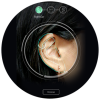It's also, for the APM, largely related to HPTF, not HRTF.
In both the APM and APP2 cases they're facing HPTF / eardrum HRTF mismatch issues (and possibly undershooting - on average ! - a bit the response in the 1-5kHz range to avoid any excess), but the underlying mechanisms for that mismatch are entirely different.
I think that Sean Olive was rather talking about the issue of inter-individual, in situ FR variation, rather than anything related to active systems.
The APM's active systems, relying on the internal mic, seem to only operate up to around 1kHz, in all modes. In that band there shouldn't be a lot of reasons to have the FR vary from one individual to the other based on anatomical features, the goal rather being to maintain the response as consistent as possible regardless of coupling / leakage. Above 1kHz I haven't seen much evidence that they're doing anything with active systems.
The APP2's active systems operate up to around 4-5kHz in all modes and seem to try to ensure a consistent response at the eardrum for all individuals, which actually could very well be not desirable in the 1-5kHz region, but still better than letting the response vary in a way similar to passive IEMs or even worse active IEMs with a "classic" feedback system operating up to 500-800Hz (which is great for controlling leakage, but amplifies HPTF / eardrum HRTF mismatch in the mids in some cases).
Bose's CustomTune feature operates up to around 5-6kHz or so, and this time does seem to try to individualise the response at the eardrum in the 1-6kHz band, at least based on ear canal length, but it's a one-off measurement at startup, while Apple's systems are continuously updated using playback content as measurement signal.
Whether these active systems operating past 1kHz are doing a good job or not across a large sample of individuals remains to be tested outside of these companies R&D's labs.
In all three cases ear geometry is not used with their onboard active systems, but as @staticV3 mentioned, Apple uses the iPhone's depth sensor to at least partly individualise the HRTF map / ITD / ILD (?) when using their binaural renderer.
Apple has a patent to reduce HPTF issues based on scans of one's face, but I don't think that it's been applied in their product. They also seem to have floated the idea of using structured light sensors inside the ear cup of their over-ears to have a rough image of the user's ear, but again it seems like a far-fetched idea rather than a directly applicable patent, and mostly aimed at identifying left and right ears.
If Harman 2018 also means adding compression, maybe. And "maybe", as you're facing HPTF issues anyway, so difficult to know for certain.
Not a given depending on the actual exact model and the part of the spectrum under consideration in general. But for the APM, just like with most ANC over-ears indeed, it's very reliable in the range where their active systems operate (here up around 800Hz), not so much above.
Apparently AirPods Max gen 2 is imminent. Some updates indicated there but I haven't researched fully yet,




